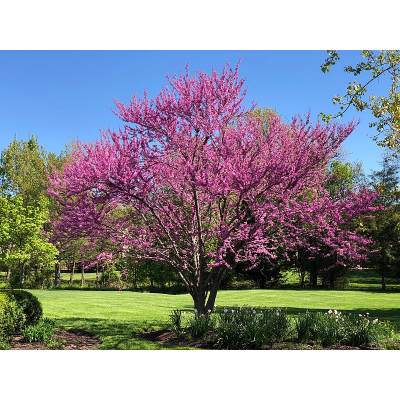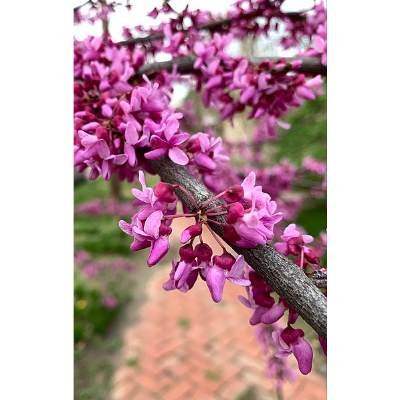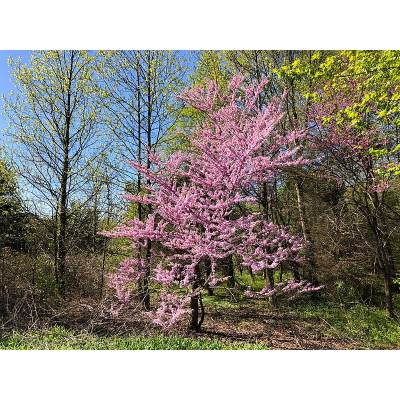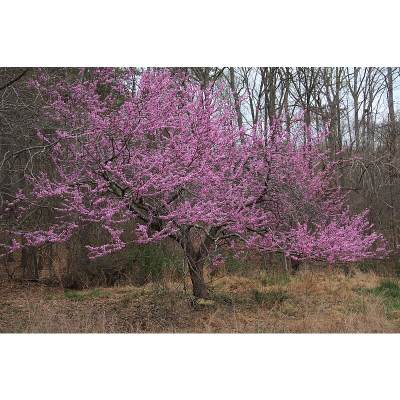The Eastern Redbud tree, Cercis canadensis, offers numerous advantages for your landscape.
It boasts ornamental beauty, early spring blossoms, provides a habitat for wildlife, and is drought-tolerant, low-maintenance, and versatile in landscaping.
This small native tree also aids in erosion control and offers shade.
However, it has its downsides, including a short bloom period, vulnerability to canker diseases, limited shade coverage, shallow roots, and susceptibility to pests, soil compaction, pollution, and leaf drop in hot summers.
| Pros | Cons |
|---|---|
| Ornamental Beauty | Short Bloom Period |
| Early Spring Blossoms | Vulnerability to Canker Diseases |
| Wildlife Habitat | Limited Shade Coverage |
| Drought Tolerance | Shallow Root System |
| Easy Maintenance | Attracts Pests |
| Small Size | Invasive Root Growth |
| Landscape Versatility | Susceptible to Soil Compaction |
| Erosion Control | Requires Well-Drained Soil |
| Shade Provider | Sensitive to Pollution |
| Native Species | Potential for Leaf Drop in Hot Summers |
Pro: Ornamental Beauty
The Eastern Redbud tree is a splendid addition to any landscape, revered for its ornamental beauty.
Its heart-shaped leaves, which turn from green to vibrant shades of yellow, orange, and red in the fall, create a visual feast. When in bloom, clusters of bright, rosy-pink or purple flowers adorn its branches.
This stunning display is a sight to behold and adds a touch of elegance to your garden.
Furthermore, the Eastern Redbud tree’s distinctive bark is both smooth and scaly, creating an appealing visual texture that stands out in the winter months. It’s a tree that keeps your landscape looking charming year-round.
Pro: Early Spring Blossoms
One of the most captivating features of the Eastern Redbud tree is its early spring blossoms.
These vibrant, colorful flowers emerge before the leaves, creating a striking visual contrast against the tree’s bare branches. The tree’s ability to bloom so early in the year makes it a symbol of hope and rejuvenation after the long, dreary winter months.
The blossoms are not only visually appealing but also attract pollinators like bees and butterflies, making it a valuable addition to any garden or natural area.

Pro: Wildlife Habitat
Eastern Redbud trees play an essential role in providing habitat and sustenance for various wildlife. Birds, in particular, are drawn to the tree for its blossoms, seeds, and shelter. Songbirds often nest in its branches, making it an excellent choice for birdwatchers and nature enthusiasts.
The tree also supports the life cycles of several native butterfly species, making it a focal point for those interested in conservation and preserving biodiversity in their landscape.
Also Read :
Redbud Trees Pros and Cons – 12 Facts You Need to Know
Celebration Maple Tree Pros And Cons – 8 Facts You Need to Know
Brandywine Maple Tree Pros And Cons – 7 Facts You Need to Know
Chitalpa Tree Pros and Cons – 9 Facts You Need to Know
Purple Robe Locust Tree Pros and Cons – 10 Important Facts
River Birch Tree Pros and Cons – 16 Facts You Need to Know
Hickory Tree Pros and Cons: 7 Facts You Need to Know
Hazelnut Tree Pros and Cons – 10 Facts You Need to Know
October Glory Maple Tree Pros And Cons – 9 Amazing Facts
Pro: Drought Tolerance

The Eastern Redbud tree is well-known for its ability to withstand drought conditions. It is a hardy tree that can thrive in areas with limited water resources. This drought tolerance not only makes it a resilient choice but also reduces the maintenance required to keep the tree healthy and vibrant.
The tree’s adaptability to various soil types, including those prone to dryness, means it can flourish in a range of environments, making it an attractive option for xeriscaping and water-conscious gardening.
Pro: Easy Maintenance
For those seeking a low-maintenance addition to their landscape, the Eastern Redbud tree fits the bill. Its compact size and relatively simple care requirements make it an ideal choice for busy individuals or those new to gardening.
The tree generally requires minimal pruning, and deadheading spent blossoms is the primary maintenance task. With its hardy nature, it can thrive with minimal intervention, allowing you to enjoy its beauty without the hassle of extensive upkeep.
Pro: Small Size
The Eastern Redbud’s modest size is a significant advantage. It typically reaches heights of 20-30 feet, making it suitable for both small and large landscapes. Its compact form allows you to plant it near buildings or in tight spaces without the fear of overwhelming your property.
This small size also contributes to its manageability, making it an excellent choice for homeowners who prefer trees that don’t require frequent or extensive maintenance.
Pro: Landscape Versatility
Eastern Redbud trees are remarkably versatile in terms of landscaping. They can be employed as single specimens, ornamental focal points, or planted in groups to create a dramatic display. Their adaptable nature makes them suitable for a range of landscaping styles, from formal gardens to natural, woodland settings.
They can also be easily pruned into various shapes and sizes, allowing you to customize their appearance to fit your specific landscaping vision.
Pro: Erosion Control
These trees are also beneficial for erosion control. Their dense root system helps stabilize soil on slopes and prevent soil erosion. By planting Eastern Redbuds strategically on your property, you can help protect against the detrimental effects of water runoff and soil erosion.
This is particularly valuable for homeowners living in areas prone to heavy rainfall or those near bodies of water where erosion can be a common concern.
Pro: Shade Provider
Although the Eastern Redbud’s primary appeal lies in its ornamental beauty, it also provides valuable shade. As it matures, the tree’s canopy expands, offering cool relief during the hot summer months. This shade can enhance the comfort and usability of your outdoor spaces.
The dappled shade created by the Eastern Redbud is especially popular for those who wish to grow shade-loving plants beneath its protective canopy.
Pro: Native Species
One of the Eastern Redbud’s greatest advantages is its status as a native species in North America. As an indigenous tree, it has coevolved with the local ecosystem, which means it’s well-suited to the region’s climate and conditions. This is not only advantageous for the tree’s health but also for the overall health of the environment.
Planting native species like the Eastern Redbud helps support local wildlife, conserves water resources, and reduces the need for excessive chemical treatments.
Con: Short Bloom Period
Despite its many merits, the Eastern Redbud tree does have its drawbacks. One notable limitation is its short bloom period. The tree’s stunning blossoms are a sight to behold, but they last for a relatively brief period in early spring. As the season progresses, the flowers give way to leaves, and the vibrant display comes to an end.
This short-lived beauty may disappoint those seeking a tree with an extended period of ornamental appeal throughout the year.
Con: Vulnerability to Canker Diseases
Eastern Redbud trees are susceptible to canker diseases, which can affect their health and longevity. Canker diseases are fungal infections that can cause blemishes, cankers, and dieback in the tree’s branches. These diseases can weaken the tree and, in severe cases, even lead to its demise.
Proper care, including regular inspections and prompt treatment, is necessary to mitigate the risk of canker diseases.
Con: Limited Shade Coverage
While the Eastern Redbud tree does provide valuable shade, it’s essential to note that its shade coverage is limited compared to larger shade trees like oaks and maples. The tree’s smaller size and relatively sparse canopy mean it may not cast as much shade as some homeowners desire for their outdoor spaces.
If your primary goal is to create extensive, cooling shade, you may need to supplement the Eastern Redbud with other shade-providing trees or structures.
Con: Shallow Root System

Another potential issue with the Eastern Redbud is its shallow root system. While this is a benefit in preventing soil erosion, it can also be a drawback in some situations. Shallow roots make the tree more susceptible to drought stress, and they may compete with nearby plants for water and nutrients.
If you plan to plant other vegetation beneath or near the Eastern Redbud, careful consideration and proper spacing are required to avoid root-related conflicts.
Con: Attracts Pests
The tree’s early spring blossoms, while attractive to pollinators, can also be a magnet for pests. Aphids and scale insects are known to be drawn to the Eastern Redbud’s flowers. These pests can potentially damage the tree and reduce its overall vitality.
To counter this issue, regular inspections and the use of appropriate pest control measures may be necessary to keep your Eastern Redbud healthy. While it may attract some pests, the benefits it brings to your garden can outweigh this con.
Con: Invasive Root Growth

Eastern Redbud trees are known for their invasive root growth, which can cause problems in certain situations. The roots can extend quite far from the base of the tree, and this may lead to conflicts with nearby structures, such as sidewalks, driveways, and even the foundations of buildings.
It’s crucial to consider the placement of your Eastern Redbud and to provide adequate space to accommodate its root system without causing issues for your property.
Con: Susceptible to Soil Compaction
The Eastern Redbud tree is also sensitive to soil compaction, a common issue in urban and suburban areas. Soil compaction occurs when the soil becomes densely packed, reducing aeration and water infiltration. This condition can impede the tree’s root development and overall health.
To address this concern, it’s important to avoid heavy foot traffic or construction near the tree’s root zone and consider soil aeration techniques when necessary.
Con: Requires Well-Drained Soil
While the Eastern Redbud is adaptable to different soil types, it thrives in well-drained soil. If your property has poorly drained or heavy clay soil, this may not be the ideal tree for your garden. Waterlogged soil can lead to root rot and other issues that can harm the tree.
To maximize the health and beauty of your Eastern Redbud, it’s essential to ensure proper soil drainage or consider alternative species better suited to your soil conditions.
Con: Sensitive to Pollution
The Eastern Redbud tree is sensitive to pollution, including air pollution and soil contamination. If you live in an area with high levels of pollution, this tree may struggle to thrive. The pollutants can hinder its growth, weaken its resistance to diseases, and reduce its overall ornamental appeal.
In urban environments with significant pollution concerns, it may be more challenging to maintain a healthy Eastern Redbud.
Con: Potential for Leaf Drop in Hot Summers
During hot summers, Eastern Redbud trees may experience leaf drop, which can be disappointing for homeowners seeking a consistently lush and shaded garden. The tree’s response to extreme heat and drought can include shedding some of its leaves to conserve moisture and energy.
While this natural response is a survival strategy, it can temporarily impact the tree’s appearance. Adequate watering and shading during hot spells can help mitigate leaf drop and keep the tree looking healthy.
In conclusion, the Eastern Redbud tree has both pros and cons that must be carefully considered when adding it to your landscape. Its ornamental beauty, early spring blossoms, and contributions to wildlife habitat make it an attractive choice for many gardeners. Its drought tolerance, low maintenance, and adaptability to various landscapes further enhance its appeal.
However, it is not without its downsides, including a short bloom period, susceptibility to canker diseases, limited shade coverage, and issues related to its shallow root system and potential for attracting pests. Soil conditions, pollution levels, and the tree’s response to hot summers are additional factors that need to be taken into account when deciding whether the Eastern Redbud is the right fit for your garden.
Ultimately, the decision to plant an Eastern Redbud tree should be based on your specific landscape needs and the careful consideration of both its advantages and disadvantages. By doing so, you can make an informed choice that will enhance the beauty and functionality of your outdoor space.
